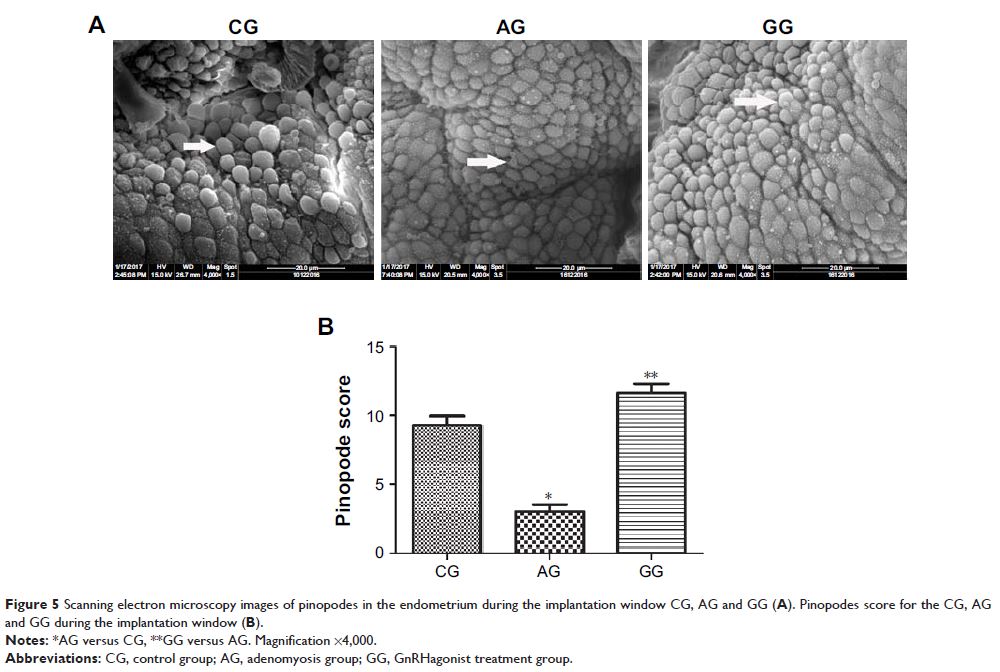108384
论文已发表
注册即可获取德孚的最新动态
IF 收录期刊
- 3.4 Breast Cancer (Dove Med Press)
- 3.2 Clin Epidemiol
- 2.6 Cancer Manag Res
- 2.9 Infect Drug Resist
- 3.7 Clin Interv Aging
- 5.1 Drug Des Dev Ther
- 3.1 Int J Chronic Obstr
- 6.6 Int J Nanomed
- 2.6 Int J Women's Health
- 2.9 Neuropsych Dis Treat
- 2.8 OncoTargets Ther
- 2.0 Patient Prefer Adher
- 2.2 Ther Clin Risk Manag
- 2.5 J Pain Res
- 3.0 Diabet Metab Synd Ob
- 3.2 Psychol Res Behav Ma
- 3.4 Nat Sci Sleep
- 1.8 Pharmgenomics Pers Med
- 2.0 Risk Manag Healthc Policy
- 4.1 J Inflamm Res
- 2.0 Int J Gen Med
- 3.4 J Hepatocell Carcinoma
- 3.0 J Asthma Allergy
- 2.2 Clin Cosmet Investig Dermatol
- 2.4 J Multidiscip Healthc

GnRH 激动剂通过恢复子宫内膜容受性来改善诱发子宫腺肌病小鼠的妊娠结局
Authors Guo S, Li Z, Yan L, Sun Y, Feng Y
Received 14 January 2018
Accepted for publication 6 April 2018
Published 7 June 2018 Volume 2018:12 Pages 1621—1631
DOI https://doi.org/10.2147/DDDT.S162541
Checked for plagiarism Yes
Review by Single-blind
Peer reviewers approved by Dr Palas Chanda
Peer reviewer comments 3
Editor who approved publication: Dr Georgios Panos
Purpose: Adenomyosis has a negative impact on female fertility. GnRH
agonist treatment can improve pregnancy outcomes in women with adenomyosis.
However, the impact of GnRH agonist upon endometrium receptivity of patients
with adenomyosis remains unclear. In this study, endometrial receptivity and
pregnancy outcome were investigated using a mouse model of adenomyosis.
Materials and
methods: Adenomyosis was induced in 12 female
ICR mice, neonatally treated with tamoxifen, while another six female mice
(control group) received solvent only. At 75 days, the induced adenomyosis
group was randomly divided into two groups: an untreated group and a group
treated with GnRH agonist (n = 6 each). Sixty days later, the mice were mated
and pregnancy outcomes were observed and compared among the three groups (n = 6
each). In a parallel experiment using the same treatment regimes, uterus
samples were collected on day 4 of pregnancy for immunohistochemistry, gene
(quantitative polymerase chain reaction) and protein expression (Western blot),
and scanning electron microscopy analyses.
Results: We found that the average live litter size was reduced in the
adenomyosis compared with control group (8 ± 0.56 versus 13 ± 0.71; P = 0.03). However, the
litter size was significantly increased in the treated with GnRH agonist group
compared with the untreated group (12 ± 0.35 versus 8 ± 0.56; P = 0.04). The uterine
expression levels of Hoxa10, Hoxa11, Lif and integrin b3 mRNA and protein were
decreased in the adenomyosis group, and were significantly increased after GnRH
agonist treatment. Additionally, pinopodes were reduced in number and poorly
developed in mice with induced adenomyosis. However, pinopodes were abundant
and well-developed in the GnRH agonist treatment group.
Conclusion: Adenomyosis may have an adverse impact on endometrial receptivity and
reduce pregnancy outcomes in mice. However, GnRH agonist may improve the
pregnancy outcome by partially restoring endometrial receptivity.
Keywords: adenomyosis, GnRH agonist, mice, endometrial receptivity,
pregnancy outcome
